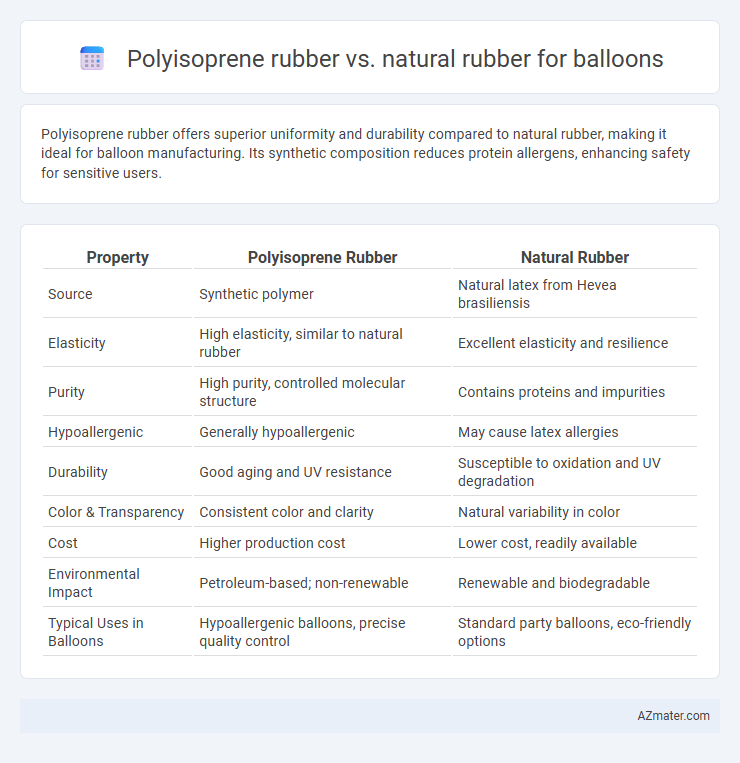Polyisoprene rubber offers superior uniformity and durability compared to natural rubber, making it ideal for balloon manufacturing. Its synthetic composition reduces protein allergens, enhancing safety for sensitive users.
Table of Comparison
| Property | Polyisoprene Rubber | Natural Rubber |
|---|---|---|
| Source | Synthetic polymer | Natural latex from Hevea brasiliensis |
| Elasticity | High elasticity, similar to natural rubber | Excellent elasticity and resilience |
| Purity | High purity, controlled molecular structure | Contains proteins and impurities |
| Hypoallergenic | Generally hypoallergenic | May cause latex allergies |
| Durability | Good aging and UV resistance | Susceptible to oxidation and UV degradation |
| Color & Transparency | Consistent color and clarity | Natural variability in color |
| Cost | Higher production cost | Lower cost, readily available |
| Environmental Impact | Petroleum-based; non-renewable | Renewable and biodegradable |
| Typical Uses in Balloons | Hypoallergenic balloons, precise quality control | Standard party balloons, eco-friendly options |
Introduction to Polyisoprene Rubber and Natural Rubber
Polyisoprene rubber, a synthetic elastomer chemically identical to natural rubber, offers enhanced purity and consistency, making it ideal for balloon production with improved elasticity and resilience. Natural rubber is harvested from the latex of Hevea brasiliensis trees and contains organic impurities that can affect balloon durability and performance. Choosing polyisoprene over natural rubber results in balloons with superior strength, reduced allergenic potential, and increased resistance to oxidation and UV degradation.
Chemical Structure: Polyisoprene vs. Natural Rubber
Polyisoprene rubber, a synthetic polymer composed of cis-1,4 polyisoprene units, mimics the chemical structure of natural rubber, which primarily consists of cis-1,4-polyisoprene chains obtained from the latex of Hevea brasiliensis. Both materials share similar molecular backbones, granting high elasticity and tensile strength essential for balloons. However, synthetic polyisoprene offers enhanced purity and uniformity, reducing allergenic proteins present in natural rubber, which can benefit sensitive users.
Manufacturing Process Differences
Polyisoprene rubber used for balloons is synthetically produced through polymerization of isoprene monomers, ensuring consistent purity and molecular weight, while natural rubber is harvested from Hevea brasiliensis latex and undergoes coagulation and vulcanization processes. The manufacturing of polyisoprene rubber allows for controlled polymer chain length and fewer impurities, resulting in enhanced elasticity and uniform balloon quality. Natural rubber requires additional refining to remove proteins and impurities, which can cause allergic reactions and variability in balloon performance.
Physical Properties Comparison
Polyisoprene rubber exhibits higher tensile strength and improved elasticity compared to natural rubber, making it more durable and resistant to deformation under stress for balloon applications. Both materials possess excellent air retention properties; however, polyisoprene offers superior resistance to oxidation and UV degradation, enhancing balloon lifespan. Natural rubber features slightly better resilience but tends to have higher impurity levels, which can affect uniformity and performance in balloon manufacturing.
Elasticity and Strength in Balloon Applications
Polyisoprene rubber exhibits superior elasticity compared to natural rubber, providing balloons with enhanced stretchability and resilience, essential for maintaining shape and durability. Its molecular structure closely mimics natural rubber but offers more consistent performance, reducing the risk of premature balloon rupture under stress. Strength-wise, polyisoprene balloons resist deformation and tearing better, making them ideal for applications requiring high elasticity and long-lasting inflation.
Allergy Concerns: Natural vs. Synthetic
Polyisoprene rubber, a synthetic alternative to natural rubber, provides comparable elasticity and strength while significantly reducing allergenic proteins responsible for latex allergies found in natural rubber. Natural rubber latex contains proteins that can trigger severe allergic reactions in sensitive individuals, making polyisoprene an ideal hypoallergenic choice for balloons. Using polyisoprene balloons helps mitigate health risks associated with latex allergy, ensuring safer use in environments with children and allergy-prone users.
Environmental Impact and Sustainability
Polyisoprene rubber, a synthetic alternative to natural rubber, offers similar elasticity and strength but has a lower environmental impact due to reduced reliance on extensive rubber tree plantations, which can lead to deforestation and biodiversity loss. Natural rubber production, while renewable, often involves land use changes and pesticide use that contribute to habitat degradation and carbon emissions. Biodegradability and recyclability of both materials vary, with natural rubber generally exhibiting better biodegradability, making it a more sustainable option for balloon manufacturing when sourced responsibly.
Cost Analysis: Polyisoprene vs. Natural Rubber
Polyisoprene rubber offers a cost advantage over natural rubber in balloon manufacturing due to its consistent production process and reduced impurities, which lower processing expenses. Natural rubber, sourced from latex, faces price volatility driven by seasonal harvest fluctuations and geopolitical factors affecting supply chains. Evaluating lifecycle costs, polyisoprene provides better long-term savings through enhanced durability and reduced rejection rates during production.
Performance in Balloon Longevity and Durability
Polyisoprene rubber offers superior balloon longevity and durability compared to natural rubber due to its synthetic purity and consistent molecular structure, which reduces degradation over time. The enhanced elasticity and resistance to UV light and oxidation in polyisoprene contribute to longer-lasting balloons with less risk of brittleness or premature popping. Natural rubber balloons tend to degrade faster when exposed to environmental factors, resulting in shorter lifespan and reduced performance in extended uses.
Choosing the Right Material for Balloons
Polyisoprene rubber offers superior uniformity and enhanced elasticity compared to natural rubber, making it an ideal choice for high-quality balloons with consistent performance. Natural rubber, while cost-effective and biodegradable, may contain proteins that can cause allergic reactions, posing concerns for sensitive users. Selecting polyisoprene rubber ensures hypoallergenic properties and better resistance to environmental degradation, crucial for durable and safe balloon applications.

Infographic: Polyisoprene rubber vs Natural rubber for Balloon
 azmater.com
azmater.com